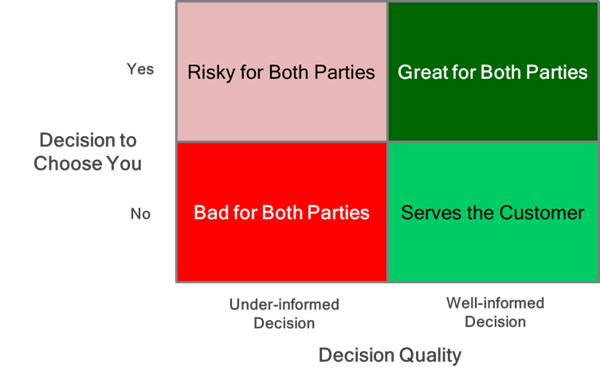Risky Business: How Marketing Content Can Take Risk Out of Business Decisions

In my younger years, I loved the thrill of a challenging winter rock and ice climb.
I found one at Maiden Cliff, which rises 800 feet above a lake in Maine. In late winter, sun-melted snow joins with natural seepage, freezes overnight, and creates giant icicles attached to the rock.
What the sun helps to create, it also taketh away. Ice that is climbable with reasonable safety in shade can, after direct sun gets on it, soften, break away from the rock, or simply melt.
My buddy and I were pleased to see a viable ice route when we arrived, and a thick cloud cover that kept the sun off the ice. Onward and upward!
Things went well—until the clouds parted and strong sunshine warmed the cliff for an hour or more. Swings of our ice axes and crampon kicks now started breaking off big chunks of ice, increasing the chances of falling and having our safety system fail.
Three quarters of the way up, we paused and debated what to do. The risks from continuing upward were obvious. But trying to downclimb or rappel down on our rope could be more dangerous. And staying where we were, however easy and even pleasant for a brief time, was a terrible option.
Up we went.
The Relationship Between Risk and Value
When there’s a lot at stake in a business buying decision, if it’s a viable option to stay where they are, people often choose to do that.
To adopt a risky innovation or decide to switch suppliers they’ve relied on, the benefits usually have to be much bigger than the risk—or sticking with the status quo has to be riskier than making a change.
I worked with a software-as-a-service company a while back that had a valuable solution that created tangible and sizable benefits for the organizations it served. The solution was very affordably priced. After a flurry of initial customers, the pace of adoption slowed. That puzzled the business owners.
Interviews with prospects and customers revealed two barriers to adoption:
- The risk lay, not in the software’s price tag, but in “What if our organization starts to totally depend on this software to run a mission-critical process, and the software fails?”
- Decision-makers’ personal risk from the buying decision. If a decision to buy doesn’t work out, individuals involved often bear reputational or career risk.
If we are to succeed in marketing valuable, often innovative solutions, or displacing relied-on competitors, we need a plan for overcoming those hurdles.
How to Use Marketing Content When Your Prospects Perceive Risk
How can you take risk out (real and perceived) for your prospective customers? If you can reduce their risk, that’s potentially quite valuable.
After all, we probably have all seen some investments with tremendous merit that should have been approved, but weren’t.
That’s illustrated by the bottom left quadrant below, where an under-informed “No” decision doesn’t serve the prospective buyer’s best interests (any more than it does yours as the seller).

(See my post “Did you lose a big sale to ‘None of the Above?’” for more on that framework.)
It is not enough for marketing messaging to bring clarity to the solution the company proposes, and the benefits and outcomes they’ll make possible for the customer.
It’s crucial to also speak to the prospective customer’s problem or aspiration, and to the disadvantages and pain of continuing to live with the status quo. It can serve prospects well to remind them that staying where they are might not be such a good option.
When buying from you represents a high-involvement decision (there’s a lot at stake), appropriate marketing communications content can help prospects develop a realistic sense of the risks of staying put, and weigh those risks against the benefits and outcomes that are available if they adopt a better solution to their problem/challenge.
The power of the right content is it allows prospects to make a series of little decisions about you.
The “right content” addresses what they most need to know about your company, your thinking, the problems you solve, and valuable outcomes you create. The right content helps prospects move through a sequence of little decisions that lead to a better-informed bigger decision about buying.
By little decisions, I mean:
- Shall they read this article or white paper about an issue?
- Listen to a podcast?
- View a webinar or a series of YouTube videos?
- Complete a self-diagnostic?
- Ask for a free consultation?
Marketing communications content can help prospects reach a better-informed judgment of whether to move ahead with an initiative or investment, or stay put for a while. Little decisions about absorbing content can lead to taking risk out of their bigger decision.
This type of content isn’t done for short-term lead generation. It’s intended to support well-informed decisions, where over time the true risks can be sorted from perceived risks and the risk/return profile weighed more accurately.
What content does your audience need from you to support their decisions in 2021?
P.S. Speaking of podcasts, I want to share this broadcast/podcast interview from The Practical CMO. Host Mark Coronna and I had a lively conversation about what makes pricing so daunting for so many businesspeople, and I outlined powerful principles that most companies can apply to improve their pricing strategy. Hope it will prove useful to you or someone you know!
Topics: Marketing Strategy, Content Marketing, Go-to-Market Strategy
Tue, Dec 29, 2020Featured Chief Outsider
/CMO-Bob-Sherlock.jpg?width=200&height=200&name=CMO-Bob-Sherlock.jpg)
.png?width=1500&height=398&name=CO_Corporate%20Logo%202021_4C_HOR_FNL-1%20(1).png)


